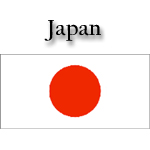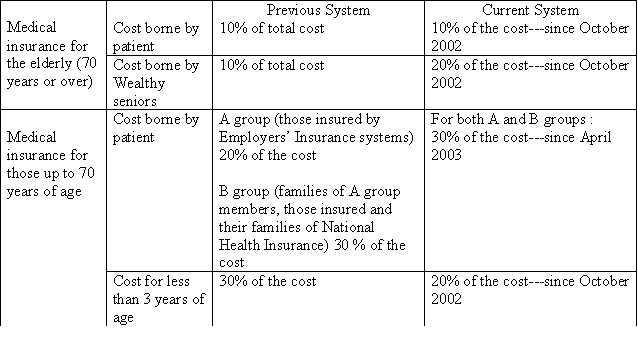

Japan is currently experiencing one of the lowest growing population rate in the country. Ever since 2003, Japans population saw an increase of only 11%. Japan is also seeing a dramatic increase in their population growth for seniors and a decline for children. Ever since 1968, Japan has just recently recorded the lowest annual population growth. Japans current population is 126,824,166. The percentage of male and female is quite equally balanced. Seniors age 65 and older account for 19.24% of the population and this number is looking to decrease. As for the remaining percentage of the population, those numbers arenít looking to increase. Though the employment rate seems to be increasing with 63.95 million people employed, with the unemployment rate decreasing 5.7%, the average household income and living expenditure is decreasing. This drastic change in the population is discovered to have a great impact on Japansí governmental sponsored programs such as the National Pension Program and the National Health Care.
![]()
Japanís government established a National Pension plan under the national pension act of 1920 to ensure the stable livelihood of their residence after old age, disability, and death. Everyone living in Japan, even foreigners who have a legal residence card, between the age of 20 and 60, is required to enroll in the plan. Under this pension plan, people are required to follow the proper guidelines to ensure that they will receive the benefits after they turn the age of 65. Under Japanís national pension scheme, contributors will be entitled to the pension payments when they reach the age of 65 only if they fulfill the designated requirement, which include premiums payments and enrollment for 25 years. For those people that enrolled in the system at a later age, such as those after 35, he/she would not be able to meet the contribution period rule. However, that person can still contribute until they reach the age of 65 and satisfy the other requirements to receive pension payments. On the other hand, there is an existing measure that has been adopted to enable foreigners, living in Japan, in their old age to entitle to the pension program. For instance, the foreigners that have been granted permanent residence would be able to receive the pension payment by counting the number of years the person has spent outside Japan. There are other entitlements such as the disability allowance, lump sum payment, and additional pension for widows for the members in the scheme. Keep in mind that benefits can be paid outside Japan if the beneficiary is resident abroad.
Japanís National Pension plan consists of these different categories (schemes). First, there is the basic scheme for those who are self-employed or unemployed, including farm worker and students. This scheme requires that all members pay a monthly contribution of Y13,300 until they turn 60. The second scheme, Employeeís Pension, is for salaried workers who work in the corporate sector. Another scheme for salary earned workers is called Mutual Aid schemes, which include those involved in the national government, local authorities, schoolteachers, and private school employees. Under these two salary type pension scheme, a worker is required to pay 13.58% of his/her annual income, and of that percentage, 50% will actually come from his/her employer. In order for the benefits to be reimburse, in addition to the monthly premiums, it is required that the member must be enrolled and paying the premiums for 25 years. They will then receive the basic pension, up to Y66,000 per month, after they turn 65 or the age based on their participation period.
The monthly-required premiums are the resources used to fund this national governmental pension plan. So, it is imperative that everyone enroll and continues to pay their monthly premiums on a regular basis.
The strategy that is used towards funding Japanís Pension Plan has raised many current issues. One of the major issues is due to Japans declining birthrate and growing share of senior citizens. Japan has the highest life expectancy span and the number of seniors is expected to continue to rise. This situation affects the amount of benefits that Japan can accommodate due to the senior lengthy payment span. Another issue is due to the lack of payments from members. Though it is legal for the law to take action, the law has been very lenient because those who fail to pay just wonít receive their pension benefits. Some of these nonpayment members of the pension actually take advantage of their leniency and continue to not make payments. Full time homemakers raise another issue. The law was changed to accommodate full-time homemakers because originally they didnít work, they didnít have to pay and then their husbands will be the only one receive his pension plan. This lead to the thought that id there were a divorce, the wife would be left without any monetary resources. The new law was designed so that full-time homemakers will also receive their own pension benefit, even though they donít pay, because it was considered that the contributions from their husband and husbandís employer paid for their coverage. This change to accommodate fulltime homemakers then raised other issues with working wives who thought that it was unfair. One way or the other, with the emerging rate of seniors, decline in birth rate, increase in unpaid monthly premiums, and the benefits that fulltime homemakers receive, Japans National Pension Plan is in the process of liquidating is resources required to continue its pension plan. The difficulty that the system faces is because of the declining birth rate and the fast growing rates of seniors in Japan. There are about 24 million age 65 or over in Japan. By 2025, life span expectancies for female are 90 years and 81 for male. On the hand, the birth rate is declining dramatically in Japan in such faster rate than any other country. The Japanís fertility rate in 2002 is 1.3, 2003 is 1.29, and the projection for 2050 is 1.39. By the rise of beneficiaries and the drop in the amount of payment contributions to the pension system, the program will affected tremendously if something isnít done.
Some possible solutions contrived to resolve their issues were to double the premium rates but that was out of the question for the workers who were already paying 13.58%. Another seemingly possible solution was to change itís funding from the employers monthly premium rates to ordinary taxes, which will eliminate the nonpayment and fulltime homemaker issues. Though taxes are a possible solution, it would require a major increase in taxes. So, until another solution is compiled that would please everyone, the future of Japanís pension plan doesnít look so bright.
![]()
Japan is also facing problem in another National program, the National Health Care System. The Health Care System consists of two parts, the National Health Insurance and the Employeeís Health Insurance. The employment health care system applies to people who are currently working for medium to large companies, national or local government, and private schools. The employees that work for the above employers would receive health insurance certificate. The determination of premiums is based on the insured personís monthly salary. Under this calculation, it will not include bonuses and deduction is about 4 percent. The newcomers to Japan will have a low premium in the first year but will increase in the following year. Members in employment this health insurance will have the opportunity to be exempt for one year without paying premiums in the case of child-care leave. These members must also participate in the Employeeís Pension Insurance scheme. People that join the scheme only pay about 20 percent for their medical costs and this would apply to their family members as well. In the case of hospitalized and outpatient costs are 30 percent. The insurance covers health issues such as injury, dental, and sickness. There will be an allowance for childbirth and long-term sickness based on the insuredís salary. However, when it comes to the death of the insured or their dependents, their funeral will be paid.
Japanís other the National Health Insurance System applies to people whom are currently not working because of retirees, students status, expectant mother, self-employed, working in agriculture and forestry or fisheries. Under this plan, members are required to pay inpatient and outpatient costs of 30 percent. For the students, they only pay 6 percent because they are entitled to a reimbursement of 80 percent of their medical costs. The premiums paid to this system are based on the insured personís salary and other factors. The most average premiums are about 4 percent of the overall salary. The diagram below shows the costs of the two Health Care System in Japan.

One of the major concerns that are dreading over Japan is due to the fact that the population for the elderly is rapidly rising which has raised many issues with Japansí current health care. Since the elderly receive social security for their health care coverage, which are funded by the National Health Insurance and Employees Health Insurance, they pay very little for health care. These funds are derived from the younger working generation and their income contributes to the health care industry. So, with the population for the elderly growing and the youths declining, this statistics is affecting the funds that are used to support this health care, which is declining. The median age of Japanese population is expected to rise from 12 years to 53 years. Another issue raised in Japansí health care is the amount of money that is being spent on medicine and hospital stay. Japan has one of the highest hospital stay time for their patients when compared to other countries. Physicians are also pushing too much medicine into their patients, which are costly. Some of the possible solution that Japan has developed is to change their current fee-for-service plan to a case-rate-payment system modeled after Germany and the United States and also by banning provider ownership of pharmacies. Other suggestions are to remove governmental subsidies so that hospitals can have a competitive playing field among other hospitals. Without these implementations or other solutions Japan can face a health care crisis in the future.
![]()
 A Health Break for Illegals [http://www.asahi.com/english/nation/TYK200401160171.html]
A Health Break for Illegals [http://www.asahi.com/english/nation/TYK200401160171.html] BBC NEWS World Edition [http://news.bbc.co.uk/2/hi/asia-pacific/3702677.stm]
BBC NEWS World Edition [http://news.bbc.co.uk/2/hi/asia-pacific/3702677.stm] Reforming Japan's Public Pensions [http://www.japanecho.co.jp/sum/2004/310502.html]
Reforming Japan's Public Pensions [http://www.japanecho.co.jp/sum/2004/310502.html] Social Insurance Agency [http://www.metro.tokyo.jp/ENGLISH/RESIDENT/LIVING/contents8.html]
Social Insurance Agency [http://www.metro.tokyo.jp/ENGLISH/RESIDENT/LIVING/contents8.html] Social Security and Health Care System in Japan [http://www.mofa.go.jp/j_info/japan/socsec/maruo/maruo_5.html]
Social Security and Health Care System in Japan [http://www.mofa.go.jp/j_info/japan/socsec/maruo/maruo_5.html]